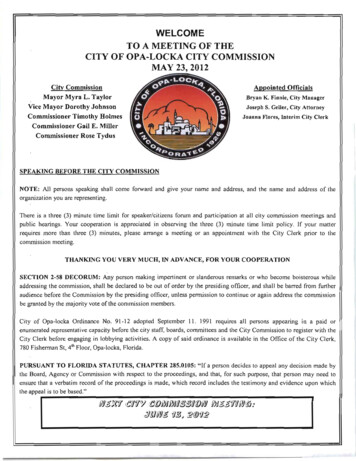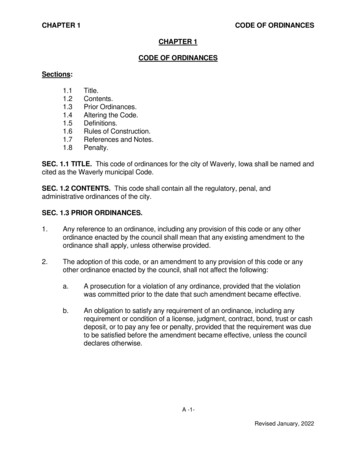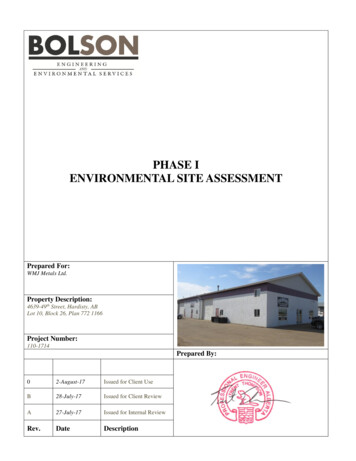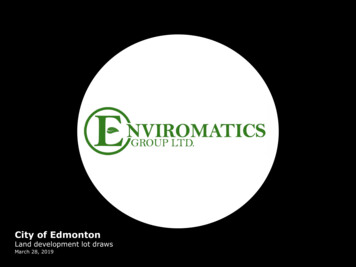
Transcription
City of EdmontonLand development lot drawsMarch 28, 2019
Introduction, overview and objectivesIntroductionsSteve JacksonPresident, Enervison and Enviromatics GroupBoard of Directors, CHBA-Edmonton tent was developed by Enervision for the City of Edmonton2
Introductions, overview and objectivesTopics we will cover todayOverview onEnergy EfficiencyWhat isEnergy EfficiencyEdmonton’sMarketBuilding Science101EnerguideLabelingKeepingItSimple
Quick overview on energyefficiency
Introductions, overview and objectivesOur homes have a significant impact on the city’s long-termsustainability and we are in a position to guide the change73% of Edmontoniansbelieve we need to take action on Climate Change19%of GHG emissions fromresidential propertiesHome builders are in a unique position to influencethe perception of energy efficiency among thegeneral public as they are viewed as trustedcontractors5
BackgroundAlberta has defined the minimum energy efficiency standards fornew homes in section 9.36 of the Alberta Building Code (ABC)Energy Efficiency requirements of Section 9.36 of Alberta Building Code (ABC) 2014 have been introduced by theGovernment of Alberta as part of the greenhouse gas emission reduction strategy6
Did you know?The cost of inaction is greaterthan the cost of action: climate change could costCanada 21- 43 billion per year by 2050BackgroundThe Pan-Canadian Framework is Canada’s commitment to do itspart on climate changeAll northernterritories19%ON19%203030% reduction of GHG emissionsbelow 2005 9Mandatory energy use labelling and disclosure forexisting buildings2022National model codes for new and existing homes(including Net Zero Energy Ready Code)AB30%2030Net Zero Energy Ready AdoptionFunding 2BLow Carbon EconomyFund 182M 150MAlberta 21.9BGreen InfrastructureHome energy efficiency 82.5MExisting retrofit 99M7NZR codes and R&D
What is energy efficiency?
What is energy efficiency?Get the same result with less effort (energy)While energy use in Canada increased 31% between 1990and 2014,it would have increased 55% without energy efficiencyimprovementsCanadians saved over 38 billionon energy in 2014 as a result of energy efficiencyimprovements since 19909
What is Energy Efficiency?The environment, envelope, mechanical systems and occupantactivities interact together to affect the efficiency of the onMechanicalsystems1Energy Education; Building uilding envelope10
What is Energy Efficiency?Many factors that contribute to an energy efficiency home these are the 3 most significant componentsBuildingEnvelopeMaterial and designAirtightnessEquipment& systems1 Change Homes or Climate Guide11
Did you know?Every 1 Million invested in EnergyEfficiency, generates 3-4 Million ofeconomic growthWhat is Energy Efficiency?As the largest contributors, improving space heating and waterheating can have a significant impact on energy efficiencyLighting Space Cooling3%4%Appliances10%Water Heating19%Space Heating64%Residential Single Detached GHG Emissionsby Energy Source and End Use (2016)1 pa/showTable.cfm?type HB§or res&juris 00&rn 7&page 02 fographic12
Did you know?You can buy a simple Energy-Starmercury-free programmablethermostat for about 30- 80What is Energy Efficiency?We are starting to get “smarter” with technology systemsSmart productsBuildingEnvelopeLightingMaterial and designOutlets& switchesAirtightnessEquipment& systems1 Change Homes or Climate GuideHubs and systemsAppliancesThermostat13
What is Energy Efficiency?The average Alberta household uses 120 Gigajoule (GJ) ofenergy per yearSo what exactly does 1 GJ of energy equate to?5,500 hoursWeb surfing30 hoursRefrigerator running3,000Bagels toasting1,230Hockey games(entire NHL season)230 hoursVacuuming100Loads of laundry1 57214
What is Energy Efficiency?To calculate how much energy a building uses, energy modellingsoftware is used and blower door tests confirm their performanceEnergy ModelThe energy consumption can relate to spaceheating, hot water heating, ventilation, lighting,appliances, and plug loads.Energy modelling starts with climate zones toensure appropriate solar radiation, wind, soiland air temperature data are appliedThe energy mode accounts for the: Effective insulation values of assembliessuch as walls, ceilings, and windows Mechanical systems that heat and ventilatethe house Size and geometry of the building Climate locationBlower door testA standardized test to measure how tightly abuilding is sealed against air leakage and heatlossCanada is divided into 11 climate zones15
Benefits of energyefficiency
Benefits of energy efficiencyThe beauty of energy efficiency is that it comes with multiplebenefitsIncreaseComfortDecreaseby better managingtemperature and noisethrough better insulationand airtightnessEnvironmentalfootprintIncreaseHealthby bettermanaging freshair throughoutthe buildingIncreaseDecreaseDurabilityEnergybillsby reducing moistureissuesIncreaseResale value17
Edmonton and homeenergy efficiency: The localmarket
Edmonton and home energy efficiency: The local marketThe demand for energy efficiency testing is already here withCanadians testing their homes at an increasing rate1.06Menergy-efficientproducts installedEnerGuide evaluations in Canadasince 2011124kNew homes50010M936kresidential solarprojects 11M inelectricity saved113,000Existing homesHouseholds received energy efficiency upgradesthrough the Residential No-Charge Energy SavingsProgram252% increaseEnerGuide evaluations in EdmontonEnerGuide labels ofparticipating homesin 81 Natural Resources Canada (NRCan) Monthly Stats, Feb 20192 Change Homes for Climate, Energuide home energy map, 0.5% increaseEnergy labels in AlbertaNew2792Exist4482017New2953Exist627201819
Edmonton and home energy efficiency: The local marketThe majority of new homes are being constructed tightAir changes per hour of new homes in AB4.543.5382%2.5of builders construct new homes with less than 2.0 ACH21.510.50B1 B3 B5 B7 B9 B11 B13 B15 B17 B19 B21 B23 B25 B27 B29 B31 B33 B35 B37 B39 B41 B43 B45 B47 B49 B51 B53 B55 B57 B59 B61# of builders# of homes10934560-11 Enervision1-22-33092608213-45 0-11-22-3834728143-44-55-66-720
Edmonton and home energy efficiency: The local marketNot all new homes are built to the same level above theminimum standard (aka reference house)100%Percentage better than reference house of new homes in AB90%80%60%70%10-20%better60%14%50%40%11%30% 10%better20-30%better20%10%0%B1 B3 B5 B7 B9 B11 B13 B15 B17 B19 B21 B23 B25 B27 B29 B31 B33 B35 B37 B39 B41 B43 B45 B47 B49 B51 B53 B55 B57 B59 B61# of builders# of Homes369844581427471 0%1 Enervision0-10%10-20%20-30%11230-40%40-50%50% 64 0%0-10%10-20%20-30%436530-40%40-50%50% 21
Energy efficiency, homevalue
Energy efficiency, home value and time on marketHome buyer preferences suggest that an energy efficient homeare the most important features201820151. Walk-in closets2. Energy efficient appliances3. Overall energy efficient home4. High-efficiency windows5. Kitchen islands6. Linen closets7. Open concept kitchens8. Large windows9. 2-car garage10.Walk-in pantryEnergy efficient appliances 90% must have or want 68% must haveHigh efficiency windows 89% must have or want 63% must have1. Walk-in closets2. High-efficiency windows3. Energy efficient appliances4. Overall energy efficient home5. Kitchen islands6. Linen closets7. Open concept kitchens8. Large windows9. HRV/ERV air exchange10.Certification by a designated program(ie. EnerGuide, Built Green, ENERGY STAR)Energy efficient home 89% must have or want 64% must have1 2015 and 2018 Canadian Home Buyer Preference National Study2 Consumers Council of Canada; Mandatory Home Energy Rating and Disclosure for Existing Houses, March 2018Home energy certification 78% must have or want 47% must have 6% not important23
Energy efficiency, home value and time on marketNationwide studies in the US show energy efficient homes sell formore, fasterCertified homes sell for9.6% more6Certified homes sell for4.2% more & 18 daysfaster6Certified homes sell for 2.1to 5.3% more9Homes that disclose energycosts sold 20 days faster 5New certified homes sold for12.9% more, 13.82 perft2 more, & 42 days faster1ENERGY STAR homes sold at 5,566 premium at 2.99per ft2 more, & 89 daysfaster10Certified homes sold for ahigher percentage of theirasking price & 31 daysfaster2Houses with one or moregreen element sell for 5.9%more21 AN MPG STICKER FOR HOUSES: HOME ENERGY LABELING, April 6, y/Webinar Energy Labeling 4 6 2017 go31177.pdfRealtor and Home Inspector Energy Efficiency Toolkit24
Energy efficientconstruction, simplified
Building science 101Key changes that affect a homes r tightnessVentilation (HRV)1Energy Education; Building uilding envelopeHigh Efficient Furnace26
Building science 1015 types of insulation are most commonly seen in AlbertaInsulation typeMaterialBlanket: batts and rolls FiberglassMineral (rock or slag) woolPlastic fibersNatural fibers Unfinished walls, including foundation wallsFloors and ceilingsFoam board or rigid foam PolystyrenePolyisocyanuratePolyurethane Unfinished walls, including foundation wallsfor new constructionUnder concrete slabs in basements (heatedand un-heated) Foam boards or foam blocks Insulating concrete forms (ICFs)Where applicable Most commonly for foundation walls fornew constructionEntire home – all exterior walls27
Did you know?Cellulose Insulation has the highest recycled content ofany insulation available; composed of 75-85% recycledpaper fiber, usually post-consumer waste news printBuilding science 101 continued, the other 2 common insulation types in AlbertaInsulation typeMaterialLoose-fill and blown-in Sprayed foam and foamed-in-place CelluloseFiberglassMineral (rock or slag) ne1 Calgary Herald, ters-for-thursday-oct-32 https://en.wikipedia.org/wiki/Cellulose insulationWhere applicable Most commonly in flat Attic spacesEnclosed existing wall or open new wallcavitiesOther hard-to-reach places Enclosed existing wallOpen new wall cavitiesUnfinished attic floorsRim joists / Floor headersCantilevered floorsFloor above unconditioned space 28
Building science 101Energy efficient windows are important to homeowners and thevarious makeup of their components all affect energy efficiencyWindows, doors and skylights can be a significant source of energy loss in your home –up to 35%Windows,doors, & skylightsAnd don’t forget about the installation. A poorly installed window, door or skylight maycause condensation, cold drafts or even allow water to leak into your homeAnatomy of an Energy-Efficient WindowFrame materialsLow-E glassGas fillsMultiple panesEnergy Calculator; Sources of Home Energy Loss, y/energy-calculator/Warm edge spacers29
Building science 101Different combinations of window types and materials yield moreenergy efficient windowsLeastEnergy efficiencyMostWindow typeFrame MaterialsWoodVinylMultiple panesSingleDoubleLow-E glass coatingHard coatGas fillsAirFiberglassAluminumTripleSoft coatArgonKrypton30
Building science 101ENERGYSTAR ratings are commonly used in Canada to depictenergy efficiency31
Building science 101Airtightness is the fundamental building property that impactsinfiltration and exfiltration and these are the common challengesPlumbingStacksMechanical Fluesand Chimneys76Skylights8AtticHatches910PotLights11Wall to CeilingWindow HeadWindow Sill5Rim JoistCantilevered Floor4Interior Wall Interface3Foundation to Sill Plateand Rim Joists2Slab Foundation Wall1b12Wall Vented Ducts13Electrical Penetrations in Wallsb32
Building science 101Energy efficient equipment and systems will minimize the energyneeded to run all equipment and systemsBuildingEnvelopeMaterial and designAirtightness4 key elements of a of high-performanceequipment and systemsHeatingCoolingEquipment& systemsVentilationHot water33
Did you know?You can cut annual heating bills by as muchas 10% a year by turning your thermostatback 10 to 15% for eight hours a dayBuilding science 101With space heating representing the highest home energy use, itoffers the most potential for cutting your energy billCanada's cold climate means that space heating accounts for a61% of the energy used in the average Canadian homeHeatingStandard efficiencyHigh efficiencyAFUE 921 Distribution of residential energy use in Canada 2016, Natural Resources egories/heating/137409598 34
Did you know?The average home collects 40 pounds of dustevery year. You can help filter out some of thisdust by installing an efficient HVAC systemBuilding science 101Ventilation is the least expensive and most energy-efficient wayto cool buildingsVentilation devices make for a healthier, cleaner, and more comfortable home bycontinuously replacing stale indoor air with fresh outdoor air.New homes built since 1977 are more airtight, which helps save energy but can makethe inside air stale.VentilationResidential ventilating productsHeat/Energy Recovery VentilatorVentilating fanCeiling fanDehumidifiersSRE %60/5066/6078/72Residential cooling and heating equipmentSmart/connectedCentral airRoom airAir source heat pumpsSEER 1416HSFP21 6.88.29.535
Did you know?Every day we breath around11,000 litres of airBuilding science 101Heat Recovery Ventilators (HRV) continuously replacing staleindoor air with fresh outdoor airHRVs reduce the energy consumption associated with heating or cooling ventilation air andhave a significant impact on meeting performance code requirementsHow an HRV works (and its components)354121 Natural Resources Canada; Heat Recovery n.gc.ca/files/energy/pdf/energystar/HRV EN.pdf2 -know-about-indoor-air-quality/36
Did you know?Canadians use an average of 75 Litres of hot watereach at home every day—for washing dishes andclothing, cleaning and showering or bathingBuilding science 101Every energy-using appliance has two price tags:The purchase price and the cost of energyWater heaters account for 19% of the energy used in the averageCanadian homeHot water1 Natural Resources Canada; Water Heaters, /water-heaters/137352 Natural Resources Canada; Water Heater a/files/files/pdf/equipment/WaterHeaterGuide e.pdf37
Building science 101Hot water use is the second largest portion of energy utilitycosts, after home heatingStorage tankThese systems store heatedwater in a tank so a quantityof hot water is stored andavailable.TanklessThis type of water heaterconsists of either an electricelement or a gas burner thatheats flowing water and doesnot have a storage tank.EF0.60.67 0.800.82Heat pumpUse electricity to transfer heatfrom the air instead ofconverting electricity directlyto heat. Heat is taken from theair in the basement or utilityroom (or sometimes fromoutside) and transferred to atank of water.Standby loss (watts)EF0.80 Electric Water HeaterThe upper element heats thewater in the upper portion ofthe tank to quickly providesome hot water if most of thehot water has been used. Afterthe upper portion of water isheated to the thermostat setpoint, the thermostat turns offthe upper element and turnson the lower element0.95 25701 Natural Resources Canada; Water Heaters, /water-heaters/137352 Natural Resources Canada; Water Heater a/files/files/pdf/equipment/WaterHeaterGuide e.pdf180.5COP3.24.55.238
Did you know?DWHR systems can reduce hotwater requirements for showeringby 40 to 60%Building science 101A drain water heat recovery (DWHR) pipe is asimple technology to save on energy used to heat waterDWHR pipes take advantage of the warm water flowing down the drains to preheat the water goinginto the hot water tank.Preheating the water reduces the amount of energy needed to heat the water to the set temperature.Efficiency (%) @ 5.7 - 19 L/min39.21 Energy Efficiency Alberta, drain-water-heat-recovery/2 Canadian Mortgage and Housing Corporation, http://192.197.69.106/en/inpr/su/sufepr/sufepr 003.cfm55.658.439
EnerGuide for homes
Energuide for homesCanada’s energy rating and labelling system that certifies theenergy efficiency of new and existing homes60 programs and regulationsare delivered using EnerGuide41
Did you know?A one-point improvement on theEnerGuide rating scale typically reducesa home’s energy consumption by 3-5%Home energy labelingAdministered by NRCAN licensed Service Organizations,EnerGuide is the official, Government backed, record of yourhome’s energy performanceNatural Resources Canada; After your Energuide home Evaluation, 57242
Home energy labelingThe EnerGuide label shows you exactly how energy-efficient yourhome is and allows you to compare against similar homes74This HouseGJ/year85GJ/yearA typicalnew house43
Home energy labellingEnerGuide home energy evaluation reports provide you with acomparative benchmark of your home’s performance44
Energy efficiency incentives: Educating your clientsCMHC offers a premium refund of up 15 of 25% to borrowerswho either buy, build or renovate for energy efficiency usingCMHC-insured financingHomes built under the following building standards areautomatically eligible for a partial mortgage loaninsurance premium refund:15%Premium Refund25%Premium RefundHomes built under eligible building standardsAutomatically eligible Built Green ENERGY STAR LEED Canada for Homes R-2000Homes NOT built under an eligible building standardMust have an EnerGuide rating less than than “A Typical New House” 15% lower 40% lowerEnergy-efficiency improvement rebatesMust show a decrease in GJ/yearPre‐retrofit rating is 200 GJ/yearDecrease by 45 GJ/yearDecrease by 90 GJ/yearPre‐retrofit rating is 200 GJ/yearDecrease by 20 GJ/yearDecrease by 45 GJ/year1 Mortgage Loan Insurance; CMHC Green Home - Helping make energy-efficient housing choices more affordable45
SIMPLE.EFFICIENT.COMPLIANCE.
So You WON a lot House DesignCall an ENERGY ADVISOR(9.36 Energy Model and COEGuidelines)Obtain Building Permit (9.36)Consider a PRE DRYWALLTESTConstruct the Home‘follow the specifications’Call ENERGY ADVISOR(Conduct Final Blower Door Test)Submit Final EnerguideRating to COE47
www.enviromaticsgroup.comEdmonton: 780-482-1771requests@enviromaticsgroup.comContent was developed by Enervision for the City of Edmonton48
Enviromatics LLP and affiliated entities.
Introductions Introduction, overview and objectives Content was developed by Enervision for the City of Edmonton 2


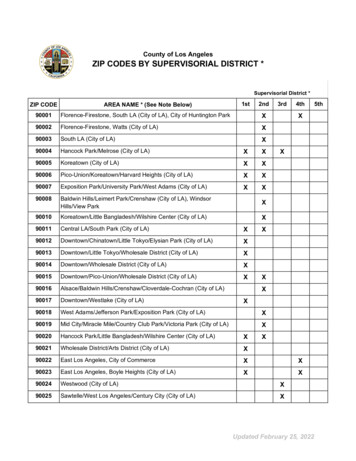


![Josh Smith - Agility [Read-Only]](/img/8/disaster-planning.jpg)
